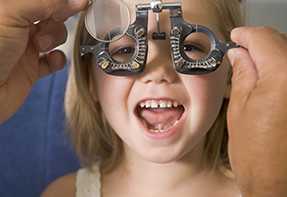Treatment for Binocular Vision Conditions

Poor Binocular (2-eyed) Coordination
Vision Therapy helps individuals develop normal coordination and teamwork of the two eyes (binocular vision). When the two eyes fail to work together as an effective team, performance in many areas can suffer (reading, sports, depth perception, eye contact, etc.)
- Convergence Insufficiency (common near vision disorder) Recent scientific research — funded by the National Eye Institute and conducted at Mayo Clinic — has proven that in-office Vision Therapy is the best treatment for Convergence Insufficiency. To learn all about Convergence Insufficiency, go to:
- Amblyopia (lazy eye), Diplopia (double vision), and Strabismus (cross-eyed, wandering eye, eye turns, etc.) Vision Therapy programs offer much higher cure rates for turned eyes and/or lazy eye when compared to eye surgery, glasses, and/or patching, without therapy. The earlier the patient receives Vision Therapy the better, however, our office successfully treats patients well past 21 years of age. Recent scientific research has disproven the long held belief that children with lazy eye, or amblyopia, can’t be helped after age 7. To learn more about crossed eyes, eye turns, or lazy eye, visit any of these web pages:
- About Eye Turns: Constant (Always) or Intermittent (Sometimes, Occasionally).
- Amblyopia, Lazy Eye, and Strabismus – Not All The Same!
- Children’s Vision: Amblyopia (Lazy Eye), Strabismus (Crossed Eyes, Cross-eyed, Wall-eyed, Intermittent Exotropia, Hypertropia, Esotropia, etc.), Exophoria…
- Eye Muscle Surgery: Treatment for Strabismus, Lazy Eye, Intermittent Exotropia, etc.
- What is Amblyopia or Lazy Eye?
- What is Convergence Insufficiency Disorder, Intermittent Exotropia, Exophoria?
- What is Seeing Double or Double Vision?
- Vision Therapy Eye Exercises as Treatment for Amblyopia (Lazy Eye), Strabismus (Crossed eyes), Convergence Insufficiency Disorder, etc.
To learn more about binocular (two-eyed) vision, visit any of these web pages:
